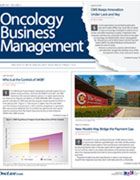Pharmacies Are Wary of Risking Revenues to Promote Value-Based Care
Major pharmacy companies are paying attention to the movement toward value-based care in oncology, but recent comments from representatives of 2 top firms suggest this sector is wary of risking capital to lower costs and improve patient outcomes.
Matthew Farber, senior director for oncology disease state management at Walgreens

Matthew Farber
Major pharmacy companies are paying attention to the movement toward value-based care in oncology, but recent comments from representatives of 2 top firms suggest this sector is wary of risking capital to lower costs and improve patient outcomes. The representatives questioned how such risk-bearing mechanisms could even be structured, and would not speculate on how to reform the costly 340B Drug Discount Program, which has boosted revenues in specialty pharmacy while contributing to the soaring cost of cancer care.
Speaking on a panel at the World Congress Oncology Access Summit in March, executives from Walgreens and Accredo-Express Scripts said they do take measures to keep costs down for the payers they have contracts with, such as creating custom drug formularies and participating in limited pharmacy networks. While physicians and nurses often express frustration over the requirement to send patients to specialty pharmacies that do little to ensure adherence or monitor for side effects, the pharmacy company representatives said their pharmacists do work to educate patients and make sure they take their medications as prescribed.
Yet the speakers said it is unlikely their companies will accept risk in the near future for making sure such interventions actually help patients or save money. Matthew Farber, senior director for oncology disease state management at Walgreens, said it was unclear how his company could participate in an alternative payment model (APM) such as CMS’ Oncology Care Model (OCM), which rewards doctors financially for meeting performance measures and potentially sanctions them for falling short. Farber said pharmacy issues are not a prominent part of the OCM, although the model does mention the importance of medication therapy management (MTM). “So, it kind of goes back to the question, what’s our role in all of it? How do these practices track MTM when it has to go to an external specialty pharmacy?” he asked.
He was similarly skeptical about pharmacies participating in some version of a clinical pathway. Payer pathways discourage doctors from prescribing more expensive drugs and often reward them for choosing less-costly alternatives. Farber said involving pharmacies doesn’t “necessarily make sense” because any new pathways would also have to be adopted by practices, which are already struggling with excessive administrative burdens.
He did say the growth of APMs and costly oral therapies will eventually make pay-for-performance contracts “something that we need to start looking at” in the pharmacy business, but he questioned how they would work. “How do you measure that? At what point does it start becoming my doing, and not the doctor’s doing?” Farber asked. In addition, “if patients are staying out of the emergency room or they’re staying on their therapy, it’s not the easiest thing to measure.” If a practice and a payer together decided they wanted a pharmacy to engage in more patient outreach, the pharmacy company would have to ask, “Are we able to affect patient care that way?” Farber said.
Bill Martin, a vice president and general manager at Accredo-Express Scripts, a mail-order pharmacy and the nation’s largest pharmacy benefit manager (PBM), had a similar message. When asked about the prospect of pay-for-performance models for pharmacy companies, he said his company is in a number of “innovative contract structures” with payers but is not being held financially accountable for patient outcomes. The risk for “the provider making good decisions…is still not being transferred to the pharmacy,” Martin said. “We haven’t hit that point.” He did not describe the existing contracts in detail but said the structures relate to reporting data on prescriptions and support provided to patients.
Express Scripts does have some value-based partnerships with drug manufacturers, including the Oncology Care Value (OCV) program it launched last year. Under the OCV, Express Scripts steers patients toward preferred medications for multiple myeloma, non—small cell lung cancer, prostate cancer, and renal cell carcinoma in exchange for discounts from the drug makers.1 For certain drugs, the company varies the cost it charges payers according to the drug’s efficacy and the patient’s disease, and refunds payers if patients stop taking their medicine. Express Scripts also says its therapeutic resource center boosts patient adherence rates by 5% compared with other pharmacies.2
Another speaker on the World Congress panel, Marc Richmond, MD, of Blue Shield of California, noted that a number of risk-sharing agreements directly between payers and drug manufacturers have been attempted. The agreements did not involve pharmacies or pharmacy benefit managers; they typically rewarded manufacturers for a medication’s effectiveness or patient adherence.3
Farber and Martin also discussed the higher spending resulting from the federal 340B Drug Pricing Program, which boosts hospital revenues while raising total healthcare costs and contributing to higher drug prices. The growing use of 340B “puts even more pressure on the top-line cost of the drugs” and is unsustainable, Martin said. “It will either eat the world, or it’s going to have to be changed.” Yet he and Farber did not offer solutions to the problem. Walgreens is the country’s leading operator of 340B contract pharmacies, but Farber said it acts strictly as a middleman. “We have absolutely zero say in how those savings are determined and get passed on through the system,” he said. He also said Walgreens contract pharmacies are mostly corner retail outlets that handle few oncology prescriptions.
Richmond and the fourth panel speaker, Brandon Hunter of Blue Cross and Blue Shield of North Carolina (BCBSNC), said their companies are involved in numerous programs to promote value-based care. These include accountable care organizations, risk-sharing with physician groups, incentives to encourage use of clinical pathways and less expensive drugs, and efforts to promote community oncology.
Hunter, manager of care redesign at BCBSNC, said the company just launched an oncology data project with AIM Specialty Health to better understand what constitutes a quality outcome. Starting April 1, 2017, AIM began collecting clinical data from oncologists in BCBSNC’s network that the payer will combine with claims data to help it build incentive programs and pathways. The information will be made available to practices so they and BCBSNC can “start talking about what value looks like,” Hunter said.
Hunter acknowledged that community oncology is generally much less expensive than hospital oncology but said a number of factors make it difficult to encourage patients to go to community practices. One is 340B, which provides hospitals with additional revenues they spend to advertise their oncology services, helping them pull patients away from community practices, he said. Private practices are ineligible for 340B discounts, further hurting their revenues.
But when Hunter’s company organized a summit of community oncologists 2 years ago, it became clear that inequitable drug costs were not the only issue putting them at a competitive disadvantage. For example, despite the clear financial benefits of having patients go to community practices in Charlotte and Durham rather than Duke University Medical Center, it’s an uphill fight persuading them to do so, he said. “A patient gets cancer, and they know they have Duke in their backyard. ‘Why wouldn’t I go to Duke? I want to go to Duke because Duke is better.’ Well, do we know that they’re better? I don’t know that they’re better. All these people went to medical school together,” he said.
Hunter said he lacks the data on patient outcomes that could convince the employers that buy his company’s insurance plans that private-practice oncologists are just as effective as their hospital counterparts. “How do we figure out a way to advertise that? I have to have some way to measure what that quality is,” he said. “I need to determine some way, hopefully a third-party objective way, to say that Dr Smith in his community practice in downtown Durham is just as good an oncologist and has as good outcomes as they do at Duke. But until I have a way of doing that, I can’t overcome that sense that (Duke) is better.” An employer can require his workers to use community practices in a way that a payer cannot, Hunter said.
References
- Kelly LF. Express Scripts leads indication-specific pricing with launch of OCV program. Drug Benefit News. https://aishealth.com/archive/ndbn020516-02. Published February 5, 2016. Accessed March 29, 2017.
- Express Scripts. Enhancing our industry leading SafeGuardRx programs. http://lab.express-scripts.com/lab/insights/drug-options/enhancingour-industry-leading-safeguardrx-programs. Published December 12, 2016. Accessed March 29, 2017.
- Good CB. Pharmaceutical risk sharing agreements. Veterans Health Administration. http://www.amsus.org/wp-content/uploads/2014/05/ RxRiskSharingAgreements_Good1.pdf. Published June 2014. Accessed March 29, 2017.




